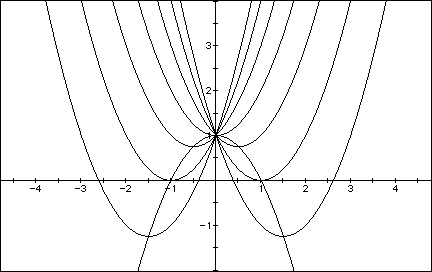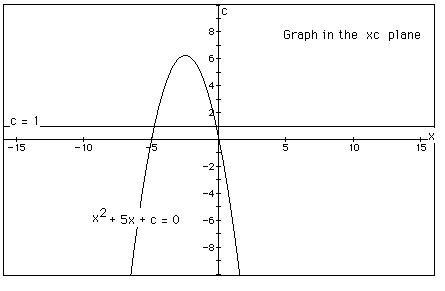
The Department of Mathematics Education

It has now become a rather standard exercise, with availble
technology, to construct graphs to consider the equation
and to overlay several graphs of
for different values of a, b, or c as the other two are held
constant. From these graphs discussion of the patterns for the
roots of
can be followed. For example, if we set
for b = -3, -2, -1, 0, 1, 2, 3, and overlay the graphs, the
following picture is obtained.

We can discuss the "movement" of a parabola as b
is changed. The parabola always passes through the same point
on the y-axis ( the point (0,1) with this equation). For b <
-2 the parabola will intersect the x-axis in two points with positive
x values (i.e. the original equation will have two real roots,
both positive). For b = -2, the parabola is tangent to the x-axis
and so the original equation has one real and positive root at
the point of tangency. For -2 < b < 2, the parabola does
not intersect the x-axis -- the original equation has no real
roots. Similarly for b = 2 the parabola is tangent to the x-axis
(one real negative root) and for b > 2, the parabola intersets
the x-axis twice to show two negative real roots for each b.
Now consider the locus of the vertices of the set of parabolas
graphed from
Show that the locus is the parabola
It is important for students to visualize the path of the locus and to generate the equation of the locus from this visualization and from the coordinates of the plotted points.
Here we see the graph of the set of the parabolas overlayed
witht the graph of the locus.

Consider again the equation
Now graph this relation in the xb plane. We get the following
graph.

If we take any particular value of b, say b = 3, and overlay this equation on the graph we add a line parallel to the x-axis. If it intersects the curve in the xb plane the intersection points correspond to the roots of the original equation for that value of b. Notice that this follows the graphical approach to solving a system of equations. In this case, we have the two equations

For each value of b we select, we get a horizontal line. It is clear on a single graph that we get two negative real roots ( the intersection of the horizontal line and the hyperbola) of the original equation when b > 2, one negative real root when b = 2, no real roots for -2 < b < 2, One positive real root when b = -2, and two positive real roots when b < -2.
The value of this exercise being that it provides students
the opportunity to find the roots of a parabola using an alternative
method. It also emphasizes the idea that a and c are constant
with only the value of b changing. It is also valuable for students
to be able to determine the equation to be graphed in the xb plane.
Consider the case when c = - 1 rather than + 1, shown here in
red.

We may again find the roots of the original equation by locating the intersection of the hyperbola and horizontal line. In this instance with c = -1, notice that for all values of b there will be one negative real root and one positive real root.
In the following example, the equation
is considered. If the equation is graphed in the xc plane,
it is easy to see that the curve will be a parabola. Students
should graph c = -x^2 -5x to see this parabola. This equation
will reinforce that c is now treated as y in the xc plane. For
each value of c considered, its graph will be a line crossing
the parabola in 0, 1, or 2 points -- the intersections being at
the roots of the orignal equation at that value of c. In the graph,
the graph of c = 1 is shown. The equation
will have two negative roots -- approximately -0.2 and -4.8.

There is one value of c where the equation will have only 1
real root -- at c = 6.25 (the vertex of the parabola). For c >
6.25 the equation will have no real roots and for c < 6.25
the equation will have two roots, both negative for 0 < c <
6.25, one negative and one 0 when c = 0 and one negative and one
positive when c < 0.